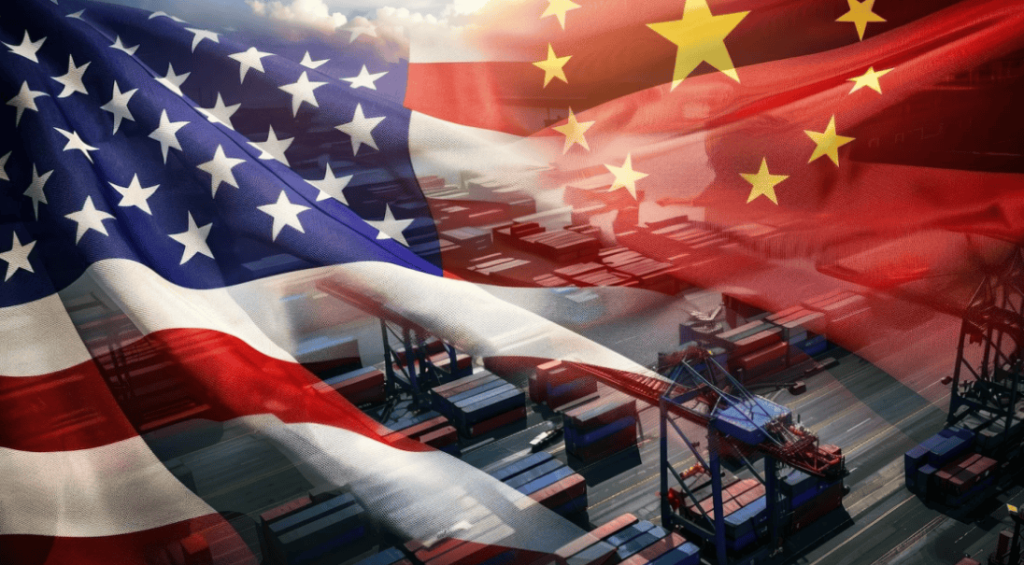The US-China relationship is arguably the most important bilateral relationship of the 21st century. This column explores the link between trade imbalance and US sentiment toward China, and shows that US communities more exposed to import competition from China experienced a greater deterioration in sentiment. The trade-induced US sentiment toward China is broad-based, encompassing political, military, and national security issues. These findings suggest competition over trade may have important geopolitical implications through their effect on local sentiment.
The US-China relationship is arguably the most important bilateral relationship of the 21st century. Together, the US and China account for almost 40% of global GDP. The bilateral relationship is one of interdependence and rivalry and reverberates onto the rest of the world. Interestingly, Baldwin (2024) points out that the US is the world’s sole military superpower and China is now the world’s sole manufacturing superpower. The large trade imbalance between the US and China has been a source of tensions.
In our new research (Arezki et al. 2024), we explore the link between trade imbalance and US sentiment toward China. Specifically, we explore whether trade-induced shocks affect sentiment toward China in local communities in the US. To do so, we use the change in China-originated import penetration to US commuting zones and an index of local news sentiment.
Our research contributes to a rapidly expanding literature quantifying attitudes and opinions using news media sources and examining the predictive power of sentiment on economic activity. Shapiro et al. (2022) show that sentiment shocks have a positive effect on consumption, output, and real interest rates. Our paper goes to the community level and inspects sentiment driven by structural exposure to trade patterns. Instead of examining the impacts of sentiment, we investigate the impact of import penetration on sentiment.
Our paper is closely related to Lu et al. (2018), who examine the effect of the surge in Chinese imports on the US media slant against China. We systematically explore non-trade topics and find a significant spillover effect of trade-induced shocks that encompasses several critical domains of public sentiment. In line with Autor et al. (2013), we exploit cross-market variation in import exposure from initial differences in industry specialisation and instrumenting for US imports using changes in Chinese imports by other high-income countries.
The increase in imports from China is used to examine how the so-called China shock affects the sentiment in US communities from 2000 to 2020. The first half of that period saw the steepest increase in US imports from China, following China’s accession to the WTO. China’s share of world manufacturing exports surged from 4.8% in 2000 to 15.1% in 2010. To track the sentiment in the communities, we construct a novel news-based sentiment index using computational text analysis methods. We extract sentiments from a database of news articles collected from the top 137 US news media sources (ranked by circulation), totalling more than 420,000 news articles and spanning more than four decades, from 1979 to 2020.
Our findings are threefold. First, US sentiment toward China peaked in 2007 before gradually turning negative. Figure 1 shows the average sentiment index computed from all US news articles referring to China, from local and national sources between 1979 and June 2020.
Figure 1 Aggregate sentiment index computed from US news articles discussing China


Notes: The line plots the annual average sentiment index value computed from all US news articles in our sample (from both local and national sources). Data for 2020 is for the first six months of the year.
Source: Arezki et al. (2024).
Prior to China’s 2001 accession to the WTO, the US sentiment toward China was one of benign neglect, with the annual average sentiment index fluctuating around zero for most years. The only exception was a considerable dip in 1989, following the Tiananmen Square massacre which led to a worsening of the bilateral relationship.
China’s accession to the WTO was followed by over a decade of a surge in China’s economic growth and rise in global importance. In this period, US-China annual trade volume increased over threefold, which coincided with positiveness towards China in the US media. The sentiment peaked in 2007 and has been declining since. The decline accelerated in 2017, coinciding with the start of the US-China trade tensions. Sharp drops brought the average annual US sentiment index toward China to negative values in 2019 for the first time since the late 1990s.
Second, we find that local US communities more exposed to import competition from China experienced greater deterioration in sentiment. And third, the trade-induced negative effect on US sentiment toward China is broad-based, encompassing political, military, and national security issues. Together, these findings suggest that competition over trade may have important geopolitical implications through the channel of sentiments in local communities.
Figure 2 plots the point estimates and 90% confidence intervals of the effect of Chinese imports on US sentiment toward China, for six semantic themes. By design, a negative estimate associated with a topic suggests that higher import competition from China reduces local US sentiment toward China, gauged by the news articles categorised into each thematic news group.
Figure 2 Heterogeneous effects of China-import penetration across themes


Source: Arezki et al. (2024).
The estimates in Panel A suggest that exposure to Chinese imports drives local US sentiment towards China downward in all thematic groups, except for General and routine news (which discusses weather, natural disasters, sports, and fashion, for example). The largest and most statistically significant effects are observed for articles in Economic news and Commodity and financial-market news.
It comes as no surprise that a strong and negative effect on US sentiment, expressed through news articles, is on themes such as economics, financial markets, and industry. However, the fact that the marginal trade-induced effect is also negative for political and social news suggests that pressure from import competition could also have important implications on non-economic dimensions of sentiment. Our findings suggest that competition over trade may have important geopolitical implications through the sentiment of local communities.
Source : VOXeu



































































